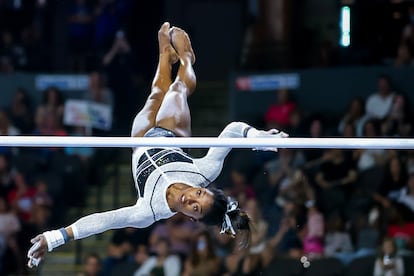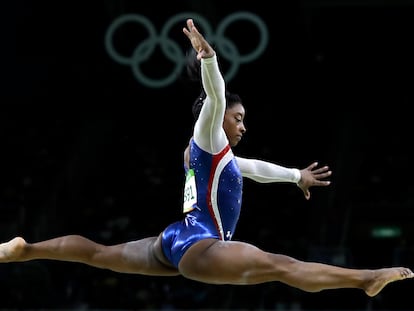Mental health in sports: How the new generations broke a taboo and learned to take a break
In recent years, mental issues among athletes have gained visibility thanks to role models like Simone Biles and Ricky Rubio; now, the focus is on prevention and tangible action


There’s no longer a taboo. There’s no more secrecy or stigma. Tennis star Carlos Alcaraz talks openly about his psychologist. So does Spanish badminton player Carolina Marín. Ricky Rubio recently announced that he is taking a break from basketball for his mental wellbeing. Simone Biles took a step back from gymnastics for two years to take three steps forward now. She left the Tokyo Olympics and today, she is thinking about the games in Paris. Over the last decade, mental health in sports has made headlines, transformed the Olympic Games and become a recurring theme in the professional sphere. An increasing number of elite athletes have spoken out about depression and anxiety, and the sports psychologist has become an indispensable figure. Now, it’s time to step it up a notch. “Visibility, messages, campaigns... it’s no longer enough. We have to go a step further. You have to focus on actionable [steps],” explains Ben Miller, the media director for Common Goal, a platform for taking action on major societal challenges.
“The emergency situations that we have been experiencing for some time now, like the pandemic, have made mental health citizens’ main concern. The issue’s visibility stems from society’s increased willingness to address an issue marked by shame, guilt and misinformation,” explains Rafael Tabarés, Professor of Psychiatry at the University of Valencia and a researcher at the Center for Biomedical Research in Mental Health Network (Cibersam). According to Xesco Espar, the former FC Barcelona handball coach and an expert in peak performance, the key lies with “athletes who dare to speak out publicly, unafraid of being stigmatized and, in so doing, normalize it.”
Rubio is the most recent example. The NBA star has decided to take a break from the sport to take care of himself. He was not well. Neither his teammates nor his coaches noticed it. “I have been around him and we didn’t see it,” said Rudy Fernández, his friend and captain of the Spanish national basketball team. His teammate, shooting guard Álex Abrines, also suffered from depression and had to leave the NBA at the beginning of 2019. He could not even step onto the court. “It’s like an injury. It keeps you from competing. You have to give the psychological recovery period its due importance just like the physical recovery period, and it depends on each athlete: some people need three months while others require a year. But taking a break shows a lot of courage,” explains María Cabrera, a sports psychologist. “People like Ricky Rubio who publicly explain this and act accordingly demonstrate their maturity and the need to take care of themselves,” says Tabarés.

“Those who start very young are the most vulnerable, especially at the beginning, and they need help managing the pressure of expectations, and everything related to their finances and [things that] can change their lives,” adds Cabrera. Like Rubio, former soccer player Irene López started competing at a young age: at 17, she won a World Cup and at 20 she announced that she was quitting soccer. She hated it: the stress, frustration and excessive demands on a player who had made her debut in the First Division at the age of 15. “Elite athletes, especially young ones, have their public identity closely linked to their personality,” explains Espar. López’s professional slump and public image ultimately became a personal failure.
Far from being isolated cases, these are common problems. According to the World Health Organization (WHO), around 280 million people around the world suffer from depression. More than 700,000 of those people take their own lives. A study conducted by the University of Toronto shows that elite athletes are more likely to experience mental health disorders, such as depression and anxiety, due to stress and excessive pressure. According to the study, over 41% of Canada’s national team athletes training for Tokyo 2020 met the criteria for diagnosing mental disorders. FIFPRO further revealed that 38% of active soccer players have suffered from symptoms of depression. “Athletes are exposed to sustained stress over a long period of time, and that causes them problems with adaptation, uncertainty or frustration tolerance,” Cabrera points out. The overloaded schedule of competitions is also a problem: “Competing away from home makes it difficult to balance [one’s] personal and professional life,” explains Espar.
The Tokyo Games marked a turning point in mental health in sports. Naomi Osaka was chosen to light the Olympic flame; a month later, ranked as the number two tennis player in the world, she dropped out of Roland Garros. “I have waves of anxiety before talking to the media,” acknowledged Osaka, who had been dealing with depression since 2018. The highest-paid tennis player lost in the third round at the Olympics. Biles experienced something similar. She stopped at the height of her career, at just 24 years old. She was suffering from anxiety. “[My] mental health is more important than sports right now,” she commented after announcing her temporary retirement. Now, after a two-year break, she has recovered and returned to competition.
Neither the most decorated Olympic medalist nor the scorer of the goal that won Spain the 2010 World Cup is exempt from depression. Andrés Iniesta also came close to giving it all up. “I fell into a pit [of despair and there was] no way out. I just wanted it to be nighttime so that I could take a pill and sleep. I had to seek help, or I knew where I was going to end up,” explained the footballer, who continues to go to therapy. His friend Dani Jarque died in 2009, and he went through a depressive period before the 2010 World Cup.
Like Iniesta, Michael Phelps also suffered from depression after announcing his retirement following the London 2012 Olympics. “I even put my life at risk. In 2014 there were moments when I didn’t want to live,” said the Baltimore swimmer, who had thought about suicide.

A change in young people
Some athletes attempted to take their own lives; others succeeded. Blanca Fernández Ochoa, the first woman to win an Olympic medal for Spain, ended her life in 2019. She had bipolar disorder. Success came too soon for her and, at the age of 56, she was found dead in the Cercedilla mountains, having been missing for days. Soccer player Robert Enke, aged 32, threw himself on the train tracks because of depression he suffered after his time with Barça and Fenerbahçe, which was aggravated by the death of his two-year-old daughter. Gary Speed, Andres Biermann and Francesc Arnau also ended their lives after episodes of mental health problems.
To prevent such cases, Common Goal — composed of some 250 footballers and coaches — has joined the fight for mental health, using soccer as a motor for change. “I’ve never seen so much interest in an issue. Everyone wants to take action,” Miller comments. He adds that one in four footballers in England has a mental health problem, a figure that has risen 49% in five years. “We work with a two-pronged model: immediate resources and help, and then offering tools and creating a network to help peers and people in the community,” Miller says.
He believes that action must come both from the top down and the bottom up, including young people, fans, managers, staff and the elite. “The power of sport is unique. We have to work on a radical change,” the head of the platform says. According to Cabrera, prevention is the goal: “sports psychologists’ activities focus on enhancing skills, beyond intervening when there is a problem.” Alcaraz, Marín and Biles share something in common: they belong to a new generation that is causing a major shift. “Young people, the kids from the new generations, are comfortable talking about mental health. That gives me faith that we have reached a turning point,” Miller says. There’s a new wave of elite athletes who comfortably talk about what’s on their minds, as well as what’s going on in their bodies. There’s no fear. There’s no taboo. There’s only everyday life. Now, it’s time to act.
Sign up for our weekly newsletter to get more English-language news coverage from EL PAÍS USA Edition
Tu suscripción se está usando en otro dispositivo
¿Quieres añadir otro usuario a tu suscripción?
Si continúas leyendo en este dispositivo, no se podrá leer en el otro.
FlechaTu suscripción se está usando en otro dispositivo y solo puedes acceder a EL PAÍS desde un dispositivo a la vez.
Si quieres compartir tu cuenta, cambia tu suscripción a la modalidad Premium, así podrás añadir otro usuario. Cada uno accederá con su propia cuenta de email, lo que os permitirá personalizar vuestra experiencia en EL PAÍS.
¿Tienes una suscripción de empresa? Accede aquí para contratar más cuentas.
En el caso de no saber quién está usando tu cuenta, te recomendamos cambiar tu contraseña aquí.
Si decides continuar compartiendo tu cuenta, este mensaje se mostrará en tu dispositivo y en el de la otra persona que está usando tu cuenta de forma indefinida, afectando a tu experiencia de lectura. Puedes consultar aquí los términos y condiciones de la suscripción digital.
More information
Archived In
Últimas noticias
Most viewed
- Sinaloa Cartel war is taking its toll on Los Chapitos
- Oona Chaplin: ‘I told James Cameron that I was living in a treehouse and starting a permaculture project with a friend’
- Reinhard Genzel, Nobel laureate in physics: ‘One-minute videos will never give you the truth’
- Why the price of coffee has skyrocketed: from Brazilian plantations to specialty coffee houses
- Silver prices are going crazy: This is what’s fueling the rally









































